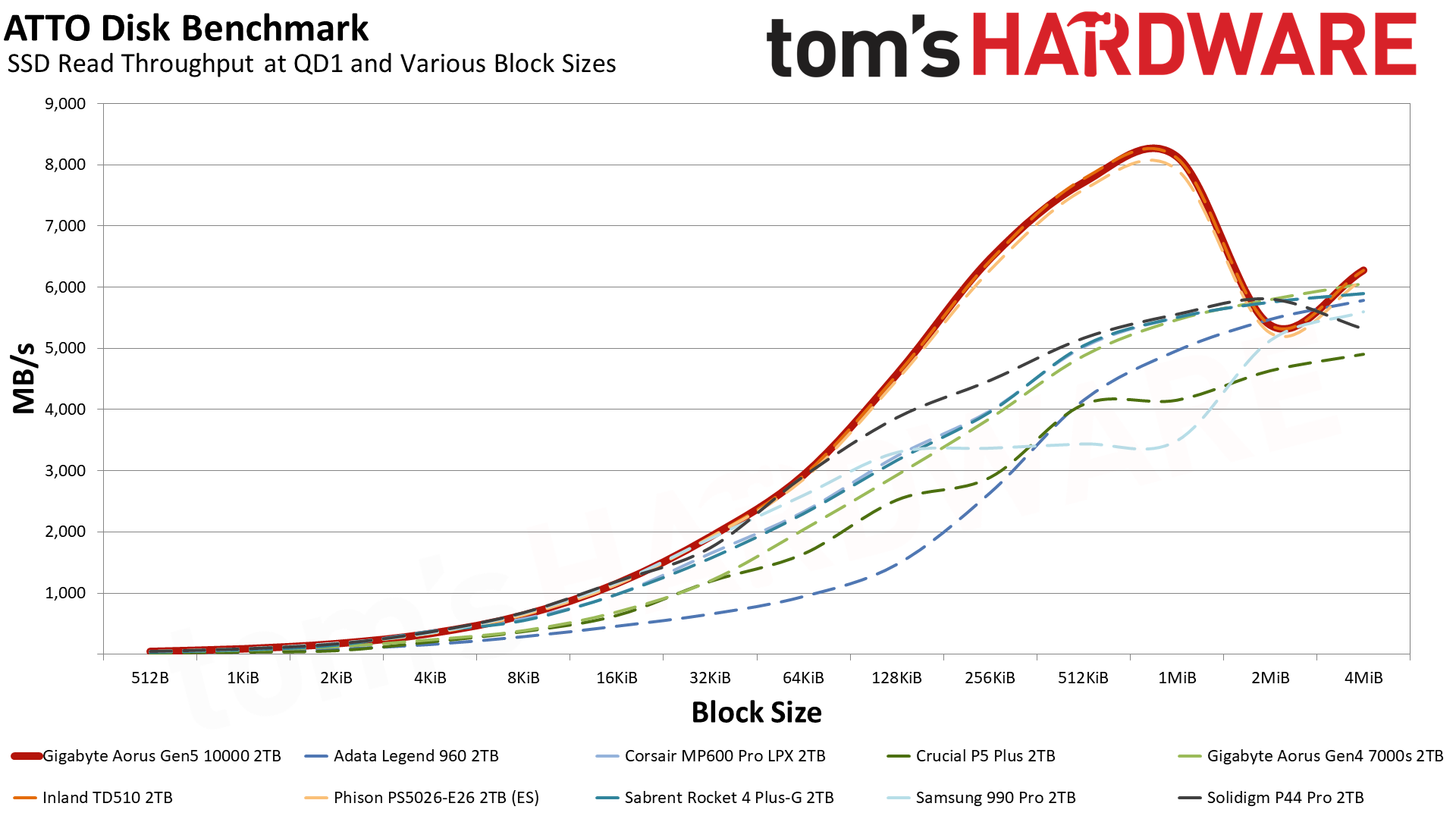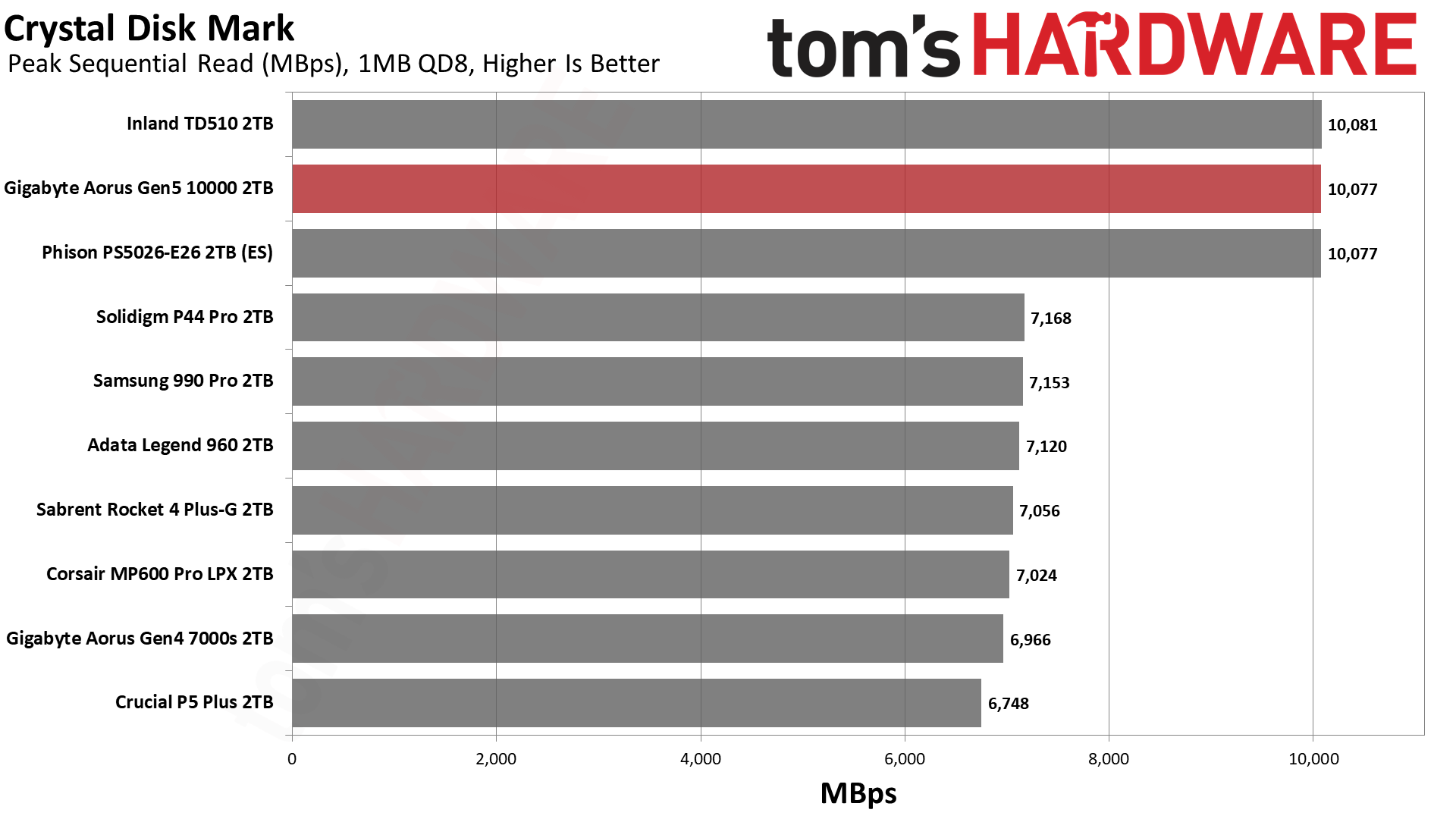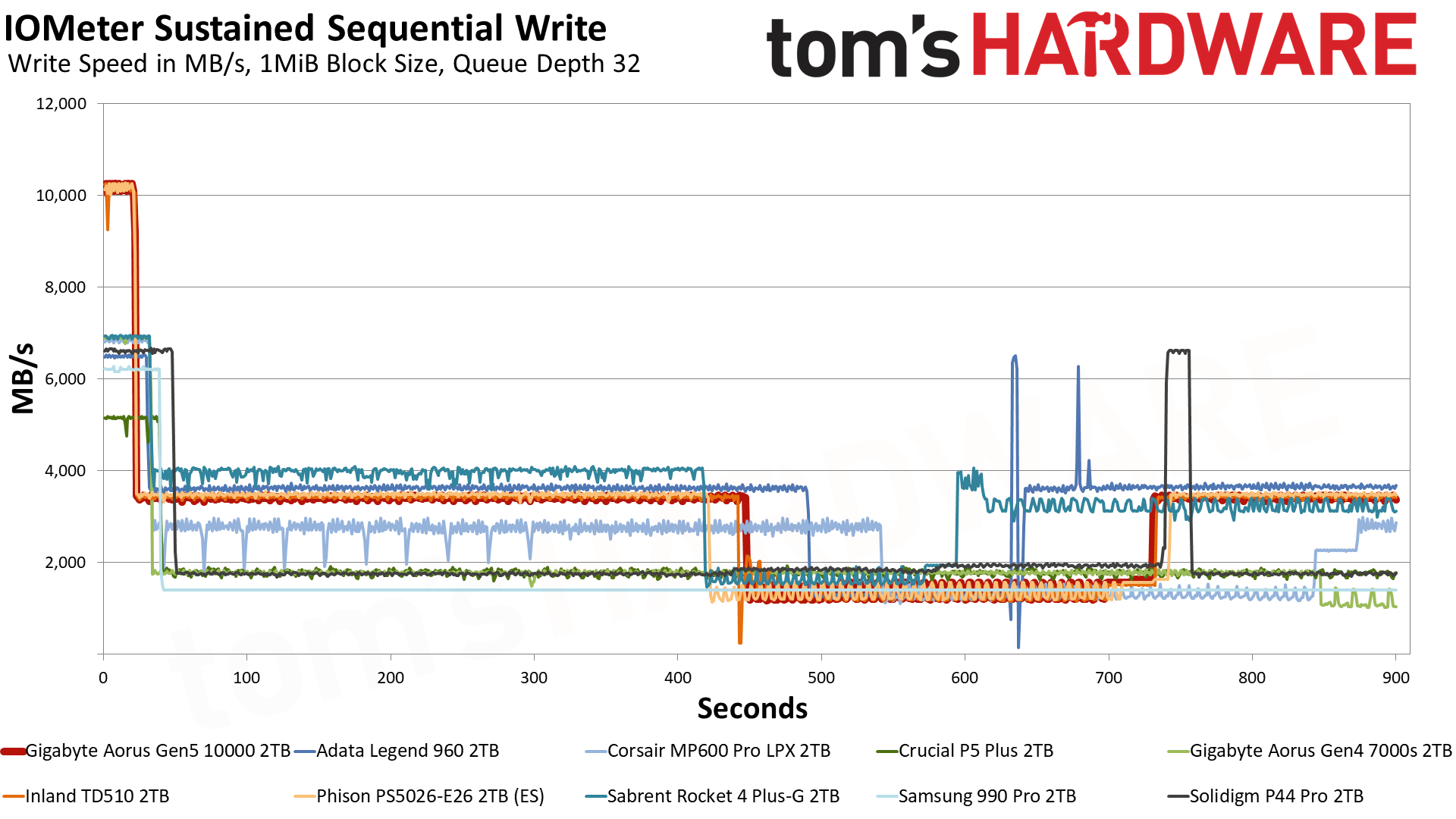Why you can trust Tom's Hardware
Comparison Products
The Gigabyte Aorus 10000 competes against two other PCIe 5.0 SSDs, the Phison E26 ES and the Inland TD510. The Crucial T700 is still currently only for preview due to unfinished firmware, but we’ll have a full review soon. We also have several high-end PCIe 4.0 drives for comparison, including the Samsung 990 Pro, the Solidigm P44 Pro, the Adata Legend 960, the Corsair MP600 Pro LPX, the Crucial P5 Plus, the Gigabyte Aorus 7000s, and the Sabrent Rocket 4 Plus-G.
Trace Testing - 3DMark Storage Benchmark
Built for gamers, 3DMark’s Storage Benchmark focuses on real-world gaming performance. Each round in this benchmark stresses storage based on gaming activities including loading games, saving progress, installing game files, and recording gameplay video streams.



The Aorus 10000 is very fast in 3DMark, beating previous drives, with only the Inland TD510 able to keep pace. The Phison ES is an electronic sample, so this drive isn't available at retail.
Trace Testing – PCMark 10 Storage Benchmark
PCMark 10 is a trace-based benchmark that uses a wide-ranging set of real-world traces from popular applications and everyday tasks to measure the performance of storage devices.



The Aorus 10000 also does well in PCMark 10, although not quite as well as the E26 ES. The latter did have some quirks that needed ironing out for launch, but consistency and reliability come before outright performance, so peak performance can vary with shipping products.
Synthetic Testing - ATTO / CrystalDiskMark
ATTO and CrystalDiskMark (CDM) are free and easy-to-use storage benchmarking tools that SSD vendors commonly use to assign performance specifications to their products. Both of these tools give us insight into how each device handles different file sizes.












The Aorus 10000 is outstanding in both ATTO and CrystalDiskMark with sequential reads and writes. It isn’t quite as fast in random IOPS, but the 4KB performance, on the whole, is good to great. This flash will need more time to mature. As it is, it’s designed for density and bandwidth first.
Get Tom's Hardware's best news and in-depth reviews, straight to your inbox.
Sustained Write Performance and Cache Recovery
Official write specifications are only part of the performance picture. Most SSDs implement a write cache, which is a fast area of (usually) pseudo-SLC programmed flash that absorbs incoming data. Sustained write speeds can suffer tremendously once the workload spills outside of the cache and into the "native" TLC or QLC flash.
We use Iometer to hammer the SSD with sequential writes for 15 minutes to measure both the size of the write cache and performance after the cache is saturated. We also monitor cache recovery via multiple idle rounds.


The Aorus 10000 writes at up to 10.2GBps in pSLC mode, 3.5GBps in TLC mode, and nearly 1.4GBps in its folding state. The real star of the show is the peak sequential write speed, but sustained write performance is not poor. We will likely see better things here in the future. pSLC recovery is slow for the up-to 220GB cache, but the drive is able to get back to its relatively good TLC performance mode without too much of a problem. If you’re interested in consistent, high sustained performance, some 4.0 drives remain equally or more viable, and at lower cost.
Power Consumption
We use the Quarch HD Programmable Power Module to gain a deeper understanding of power characteristics. Idle power consumption is an important aspect to consider, especially if you're looking for a laptop upgrade as even the best ultrabooks can have mediocre storage.
Some SSDs can consume watts of power at idle while better-suited ones sip just milliwatts. Average workload power consumption and max consumption are two other aspects of power consumption, but performance-per-watt is more important. A drive might consume more power during any given workload, but accomplishing a task faster allows the drive to drop into an idle state more quickly, ultimately saving energy.




The Aorus 10000 is simply not efficient. This is not as relevant for a drive of this type as it’s meant for fast burst performance and is an early adopter product. We will see more efficient drives later this year and next for laptops and other non-desktop devices. The Aorus 1000’s massive heatsink positions it primarily for high-end desktop use where efficiency is less of a concern.
Test Bench and Testing Notes
| CPU | Intel Core i9-12900K |
| Motherboard | Asus ROG Maximus Z790 Hero |
| Memory | 2x16GB G.Skill DDR5-5600 CL28 |
| Graphics | Intel Iris Xe UHD Graphics 770 |
| CPU Cooling | Enermax Aquafusion 240 |
| Case | Cooler Master TD500 Mesh V2 |
| Power Supply | Cooler Master V850 i Gold |
| OS Storage | Sabrent Rocket 4 Plus-G 2TB |
| Operating System | Windows 11 Pro |
We use an Alder Lake platform with most background applications such as indexing, Windows updates, and anti-virus disabled in the OS to reduce run-to-run variability. Each SSD is prefilled to 50% capacity and tested as a secondary device. Unless noted, we use active cooling for all SSDs.
Bottom Line
The Gigabyte Aorus 10000 is part of the welcoming committee for PCIe 5.0 SSDs. It’s not particularly impressive when considering what the 5.0 interface can produce in terms of total bandwidth, but it’s a good start. This is an early adopter product, but it still performs quite well on the whole with very high sequential performance. Performance is good, and it’s ready for DirectStorage when it actually arrives.
Gigabyte separates itself from the pack with an included optional heatsink that does not rely on the reference design. This drive is usable with your own heatsink or your motherboard’s M.2 heatsink. This is nice, but the question mark here is pricing. The Inland TD510 already exists with aggressive pricing, and there are faster drives in the pipeline. It is also challenging to find the Aorus 10000 in stock. Still, it’s a perfectly suitable product for what it is, being an excellent choice for enthusiasts who want the latest and greatest, particularly if their system matches the included heatsink.
MORE: Best SSDs
MORE: Best External SSDs and Hard Drives
MORE: How We Test HDDs And SSDs
MORE: All SSD Content

Shane Downing is a Freelance Reviewer for Tom’s Hardware US, covering consumer storage hardware.
-
kjfatl Where is the heat coming from? For example, is it 90% from the controller chip and 10% from the memory array? Is there a path for lower power PCIE5?Reply -
UWguy I really wish you’d start measuring the amount of heat coming from these drives. The heat sinks are downright scary.Reply -
JarredWaltonGPU Reply
We'll look into it, but you can tell by the power figures that this size of heatsink is overkill. We're talking peak power of <12W, and that's nowhere near the average power under load of 6.7W. It's not that hard to deal with 10W of power use. The Crucial T700 had a significantly smaller heatsink and was actually faster (thanks to faster NAND).UWguy said:I really wish you’d start measuring the amount of heat coming from these drives. The heat sinks are downright scary. -
kjfatl Measuring the DC power in is probably sufficient unless the PCIE termination is super-power hungry.Reply -
g-unit1111 That heat sink is completely ridiculous. How is that going to fit on any motherboard that has heat shields on it?Reply -
Roland Of Gilead Have to agree with most others. These drives are hot. They seem to run very high temps over PCIe 4.Reply
I think the heatsink is gaudy, too big of a footprint. -
waltc3 What motherboard was it tested in? Nothing with a heatsink would work in my PCie4 Aorus Master--not enough clearance under my video card. Yes, those heatsinks are non-starters--too much heat, by far. My 980 Pro PCIe4 500GB NVMe SSD runs fine and cool enough at top, sustained PCIe4 speeds without a heatsink--whereas my PCIe3.0 960 EVO 250GB NVMe will not run sustained at PCIe3.0 speeds without throttling. (When the 960 EVO was my primary NVMe drive in the 0 position, I could not do an AV scan of C:\ without the drive failing to complete the scan. No problem with the 980 Pro in the 0 slot position, with the 960 moved down to the next NVMe slot. The 960 is fine for anything that isn't sustained operation.)Reply -
SyCoREAPER I love the bend/warping the drive has.Reply
Makes me curious if there is thermal expansion and contraction at play which will affect the reliability.
